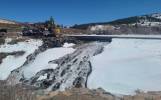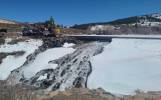Basement waterproofing – superficial vs. legitimate solutions
Any home or building that is built at ground level or contains floors below ground level is a good candidate for basement waterproofing, although there are superficial, cosmetic solutions for waterproofing a basement that really won’t solve the true problem.
Depending on the climate and geography surrounding a building, most structures need basement waterproofing to ensure that water stays out of the lowest levels and to protect the structural integrity of the building. When it rains or snows, moisture slowly seeps into the ground and accumulates in the soil surrounding the outer walls of the structure. As this soil becomes waterlogged, the pressure caused by the weight of the soaked soil pressing against the outer walls of the building starts to increase. This pressure is called hydrostatic pressure, and as it increases, water outside the building finds its way inside the building through cracks and buckling walls.
Increased moisture in the basement leads to mold and mildew, light flooding, heavy flooding and even collapsing basement walls – all of which decrease the value and usefulness of the basement space as well as the entire structure. For businesses, water-damaged basements mean less storage space as well as the potential for damaged goods already stored there. For homes, water-damaged basements mean less useable living space as well as decreased resale value for the property. Basement waterproofing is the solution for this problem, but superficial solutions only look good – they don’t solve the problem of hydrostatic pressure-induced water invasion.
An easy solution internally is to treat interior walls with Killz or similar mold-preventive coverings. Another option is to treat the walls with an internal sealant, and patch obvious cracks in foundation walls with hydraulic cement to prevent the easy access of water from the outside. This is a temporary solution for masonry walls that can be performed by just about anyone.
In poured concrete foundations, contractors can pressure-inject epoxies or urethane into the walls reaching to the exterior – successfully sealing off the path of water seepage from the outside. This type of procedure is often warrantied by waterproofing contractors to last from 10 years to the lifetime of the home.
Interior drainage is another process used to deal with water seepage from the outside. Interior drainage is not waterproofing, but rather a method of dealing with water as it enters the basement space. With interior drainage systems, underground water collects in a perimeter trench and is routed to a sump pump, where it is pumped out of and away from the home or building. The layman’s version of this process is to use a dehumidifier to collect the moisture from the air of the basement and to empty that collected water on a regular basis.
The most effective and only true form of basement waterproofing is exterior waterproofing. This process begins with excavating the exterior walls down to their base, then treating those walls with a new, polymer-based substance or by sealing the walls with a waterproofing, rolled-out rubber membrane. Drainage tiles, also known as weeping tiles or footer pipes, are then placed around the exterior walls and covered with backfilled gravel and then soil. Water that soaks into the ground after storms and snow makes its way to the drain tiles and is then carried out to the streets or city drainage system – never having the chance to accumulate and create hydrostatic pressure.
Although this is the most effective and only recognized form of true waterproofing according to the International Building Code, most property owners are hesitant to have this semi-intensive work done. Instead, they will choose the lesser options until their basements are in danger of serious compromise. The old expressions – a stitch in time saves nine, and, penny-wise but pound-foolish – come to mind when it comes to this less-than-proactive way of thinking about responsible property management and property values over time.



















